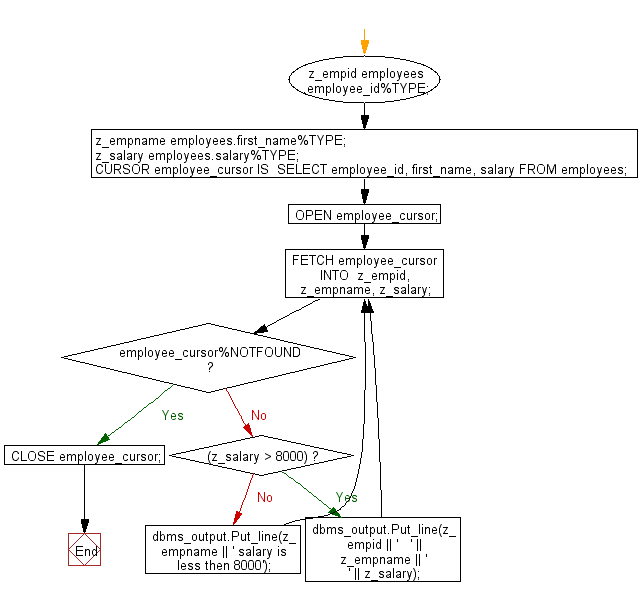PL/SQL Cursor Exercises: Retriev the records from the employees table and display them using cursors
PL/SQL Cursor: Exercise-10 with Solution
Write a program in PL/SQL to retriev the records from the employees table and display them using cursors.
Sample Solution:
Table: employees
employee_id integer first_name varchar(25) last_name varchar(25) email archar(25) phone_number varchar(15) hire_date date job_id varchar(25) salary integer commission_pct decimal(5,2) manager_id integer department_id integer
PL/SQL Code:
DECLARE
z_empid employees.employee_id%TYPE;
z_empname employees.first_name%TYPE;
z_salary employees.salary%TYPE;
CURSOR employee_cursor IS -- declaring a cursor
SELECT employee_id,
first_name,
salary
FROM employees;
BEGIN
OPEN employee_cursor; -- opening the cursor
LOOP
FETCH employee_cursor -- fetching records from the cursor
INTO z_empid,
z_empname,
z_salary;
EXIT
WHEN employee_cursor%NOTFOUND;
IF (z_salary > 8000) THEN
dbms_output.Put_line(z_empid
|| ' '
|| z_empname
|| ' '
|| z_salary);
ELSE
dbms_output.Put_line(z_empname
|| ' salary is less then 8000');
END IF;
END LOOP;
CLOSE employee_cursor; --closing the cursor
END;
/
Sample Output:
SQL> / 100 Steven 24000 101 Neena 17000 102 Lex 17000 103 Alexander 9000 Bruce salary is less then 8000 David salary is less then 8000 Valli salary is less then 8000 Diana salary is less then 8000 108 Nancy 12008 109 Daniel 9000 110 John 8200 Ismael salary is less then 8000 Jose Manuel salary is less then 8000 Luis salary is less then 8000 114 Den 11000 ...
Flowchart:

Go to:
PREV : Write a program in PL/SQL to display a cursor based detail information of employees from employees table.
NEXT : Write a program in PL/SQL to declare a record datatype with same datatype of tables using %TYPE attribute.
Improve this sample solution and post your code through Disqus
What is the difficulty level of this exercise?
